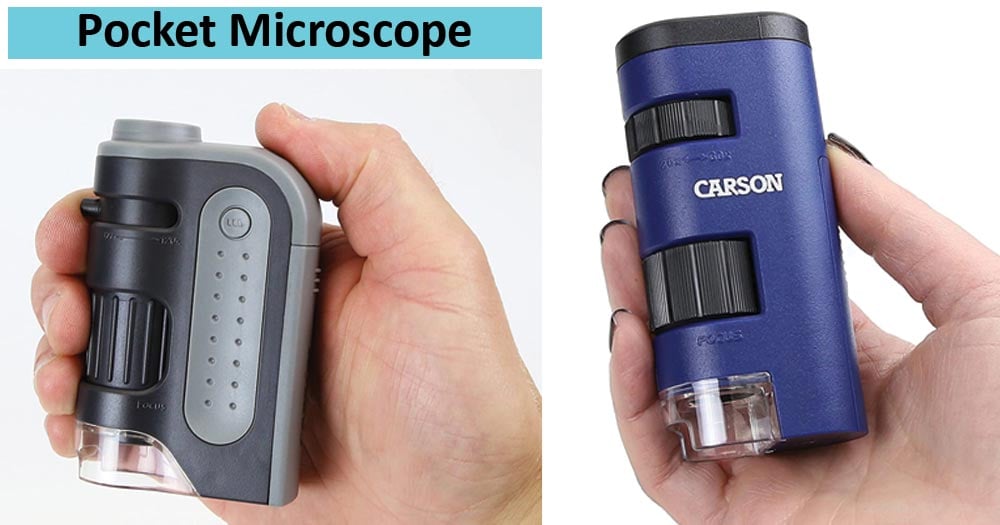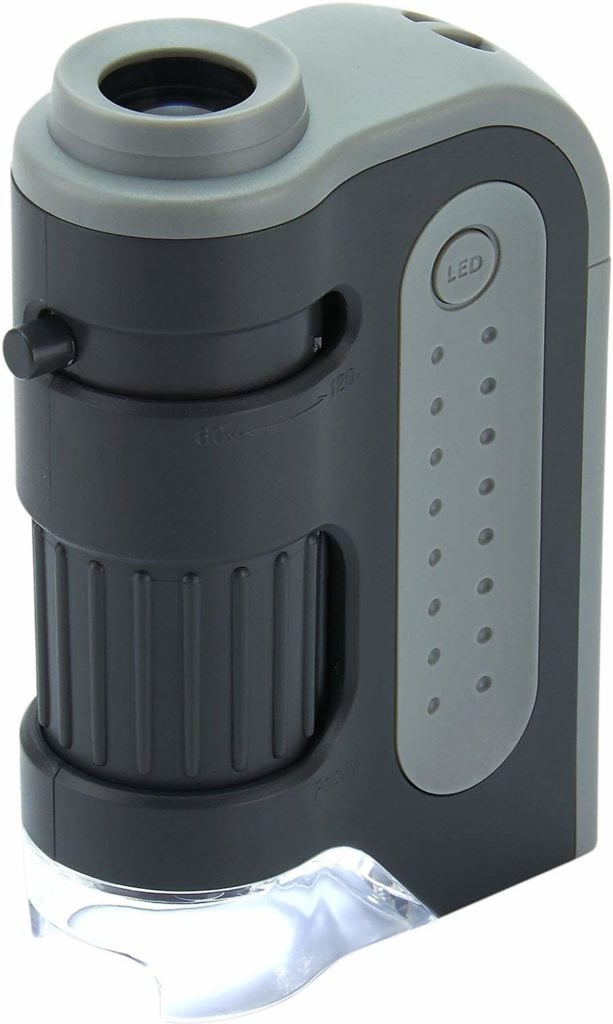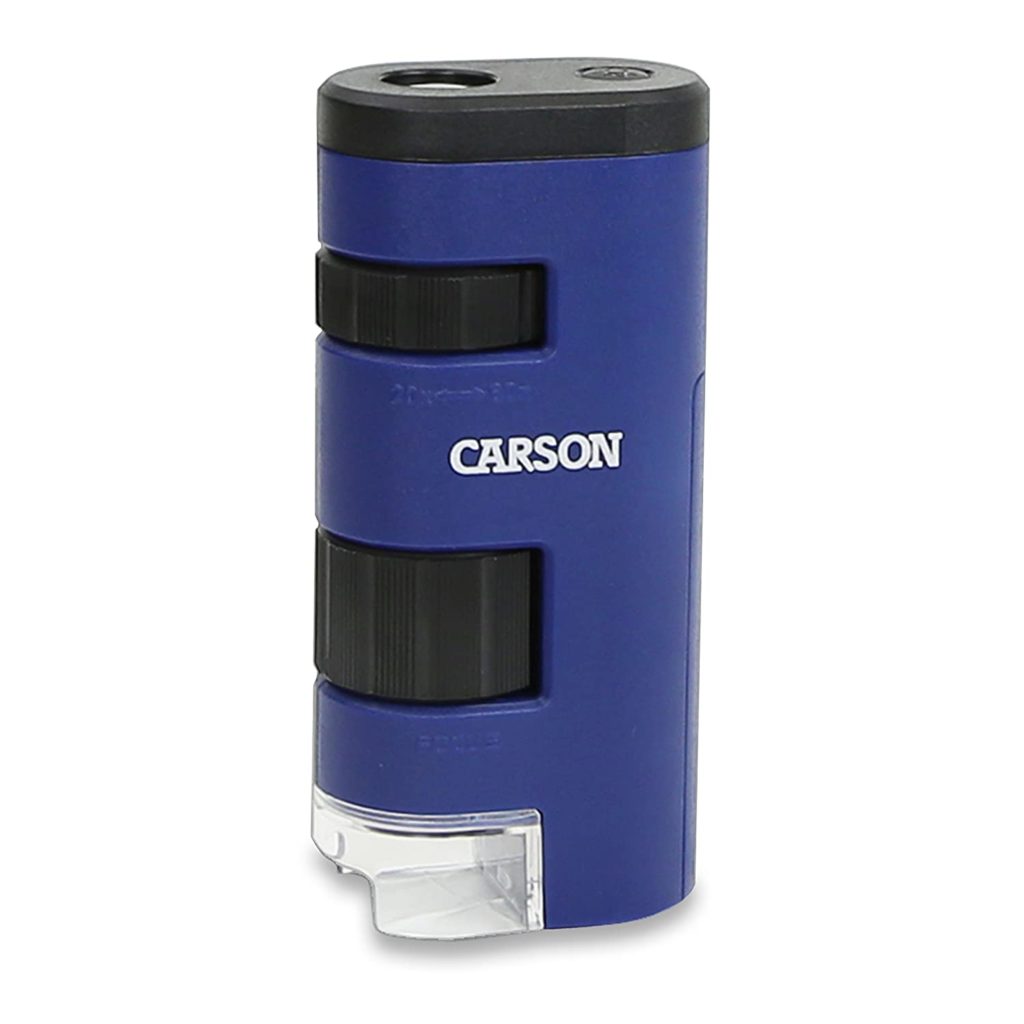Interesting Science Videos
What is a Pocket Microscope?
This is a microscope that has a special design that is small and portable, hence the name ‘pocket’. They are pocket-size but some are a bit larger. Their size is too small to hold a mirror to place the image in its rightful position. However, they have a small stage where one can put an object to view. These microscopes are portable in such a way that they can be used by both amateurs and professionals depending on the function they want to perform.

Image Source: Carson.
Pocket Microscope Principle
Most of the pocket microscopes have an eyepiece on one end and a light at the other end with a small stage where an object can be placed for observation. Some of which lack the stage, the microscope is held over the object at the right angle for viewing. Some pocket microscopes view images in reverse when the design of the microscope has a mirror and lenses to magnify the image. However, some pocket microscopes are too small to hold a mirror, which can position the image in the right place.
Parts of a Pocket Microscope
- Light source (LED) – Some pocket microscopes have an inbuilt LED light source placed at the end of the microscope.
- Eyepiece – It’s found at one end of the microscope for viewing the objects.
- Stage – It is found on some of the pockets microscopes for holding the objects for viewing.
- Mirror – It’s found on some pocket microscopes, for reflecting the image on the lens.
- Batteries – some pocket microscopes need batteries to give power or energy.
- Battery holder – Some pocket microscopes use batteries to work and this part is used to hold the batteries.
- Digital camera – Some have a digital camera attached for taking photographs of the images produced.
Types of Pocket Microscope
Depending on the model and magnification size, they can be placed in the following types:
- 30x Pocket Microscope – They show great image clarity. It’s the most common type of pocket microscope, which is quite affordable at about $10 and below. They are good learning instruments. They are small, a lightweight, and they used battery power illumination. It is majorly built for use by children (Kids Microscope) but it is NOT a toy. It can also be used to visualize jewelry.
- LED pocket microscope – They have an in-built LED light source, which makes it more powerful and efficient. It is cheaper, easy to use. they have a magnification power of 45x with a plastic body hence it cant break when it falls down. They show clear images and they have a lasting LED illumination. The most common type is SE Mini illuminated pocket microscope. It is very small hence it qualifies for pocket use. It is very cheap under $10.
- Pocket Microscope 100x – It has a high magnifying power of 100x, hence it is much better than the first two. With this high magnifying power it qualifies for use in the field but can also be used by children and hobbyists. The most common type is Carson MicroMax 60x-100x Lighted Microscope which has an inbuilt LED. It is very lightweight and easy to us They have powerful lighting coupled with good optics hence producing brightly clear images. the eyepiece is made up of rubber which makes it comfortable to use while viewing. they are also affordable pricing at $15 and below. they can also be used by children (Kids Microscope).
Best Pocket Microscopes
Carson MM-300 MicroBrite Plus Pocket Microscope

- Pocket microscope in magnification 60-120x.
- LED lighting with the aspherical lens system.
- Compact design, lightweight and you can take it anywhere.
- Box contents: 1 x MicroBrite Plus Pocket Microscope.
Click here to buy Carson MM-300 MicroBrite Plus Pocket Microscope from Amazon.
Carson MM-450 PocketMicro Pocket Microscope

- LED pocket microscope with zoom function in magnification 60-120x. The microscope provides optimal results when placed absolutely horizontally directly on the object to be examined
- LED lighting with an aspherical ground lens system ensures crystal clear and distortion-free images. The ideal instrument for all curious children, inquisitive students, hobby researchers and professionals.
- Compact design, light-weight – you can easily take the pocket microscope anywhere. The perfect tool for the detailed examination of flowers and plants, stamps and coins, fine textile structures, insects and other natural phenomena, reading small print, checking electronic circuits, and many other interesting objects
- Eye distance: 8.1 mm – 9.7 mm, weight: 54 g (without battery), dimensions (L x W x H): 5 x 3 x 10 cm
- Powered by 1 AA battery (not included)
- This pocket microscope is subject to the Carson Limited Warranty for one year.
Click here to buy Carson MM-450 PocketMicro Pocket Microscope from Amazon.
Pocket Microscope Uses
- They are size friendly, which makes them easy to use especially for children
- Their size also favors them to be used for educational purposes for children.
- Used for inspection jewelry
- Used to inspect circuit boards
- Used for photographic inspection
- Used in watchmaking
- Used in dentistry
- Used to study insects (Entomological studies)
- Used in studying coins
Advantages
- They are very portable because of their small size.
- They can be used by amateurs and professionals.
- They are very affordable (inexpensive).
Disadvantages
- They have a low magnification power of 30x-100x.
- They can not magnify images above 100x magnification power.
References and Sources
- https://www.microscope-detective.com/pocket-microscope.html
- https://www.coursehero.com/file/16243167/Mitchell-D-BIO111-2016FA-TheMicroscopeandCellStructureLab/
- https://www.androidauthority.com/best-small-android-phones-782746/
